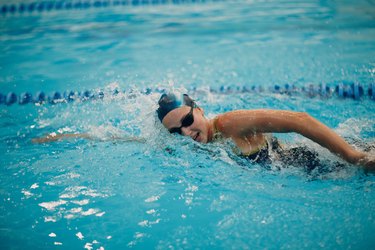
Ringworm symptoms include an itchy, ring-shaped rash. These infections are not caused by worms but rather by fungi collectively called dermatophytes. These fungi are commonly associated with hair, skin and nail infections.
Dermatophytes gravitate to moist parts of the skin, such as folds or creases, notes Medline Plus. Ringworm can also contaminate clothing and towels. Swimming pool environments, such as pool decks and showers, may provide favorable transmission conditions for ringworm infections.
Video of the Day
Video of the Day
Ringworm Symptoms and Diagnosis
Ringworm symptoms include three telltale signs. You'll notice a circular lesion that's clear in the center while spreading at the edges. Lesions are accompanied by skin redness and itching.
The Centers for Disease Control and Prevention also notes that scalp ringworm becomes scaly and flaky with a bald spot at the site of the infection. The scalp can become swollen and red. Nail-based ringworm results in thick, brittle white or yellow nails. Some ringworm infections exhibit inflamed, swollen masses that emit fluid.
Note that ringworm may be called different things depending on where on the body the infection is located. On the feet and toes, it is called athlete's foot and in the groin area, it is called jock itch.
Due to its unique appearance, your doctor may be able to diagnose ringworm with only a physical exam. In some cases, your doctor want to confirm the diagnosis with additional tests such as a culture or skin scraping.
Ringworm Treatment and Complications
Treatment of ringworm infections depends on the infection's location and severity, along with your tolerance for specific medications. For body, foot or groin ringworm, your physician may prescribe an oral or topical antifungal medication. For scalp ringworm, your doctor may also recommend an antifungal shampoo. For swollen lesions, you may also receive a course of steroids to reduce swelling, notes the University of Rochester Medical Center.
Treatment duration for ringworm on the scalp is approximately four to eight weeks. Other treatment times vary depending on the location and severity of the infection.
Ringworm infections can sometimes develop complications. The infection can spread to your nails, feet, groin or other parts of your skin. Bacterial skin infections can result from skin that's already compromised notes the University of Rochester Medical Center. Finally, your body can develop reactions or side effects from the antifungal medication.
Prevent Ringworm Infection
You can spread a ringworm infection in two ways. The CDC notes that the infection can be transmitted from one person's skin to another. For example, your child can be infected while playing with his friends at the pool. Ringworm can also be spread by contact with contaminated clothing. This can occur when a damp pool towel used by an infected swimmer is then used by her friend.
You can help prevent ringworm transmission by following some simple recommendations. If you have an active ringworm infection, stay away from the pool until the infection has completely healed. Scrub showers and tubs with bleach or fungicide.
Wash your bedding, clothes and towels thoroughly. Don't allow anyone else to use your brushes, hats or towels. Finally, cover lesions so others don't become infected through skin contact.
- Medline Plus: "Ringworm"
- Centers for Disease Control and Prevention: "Symptoms of Ringworm Infections"
- Centers for Disease Control and Prevention: "Ringworm Risk & Prevention"
- University of Rochester Medical Center: "Ringworm in Children"
- Medline Plus: "Clotrimazole Topical"
- University of Rochester Medical Center: "Tinea Infection"